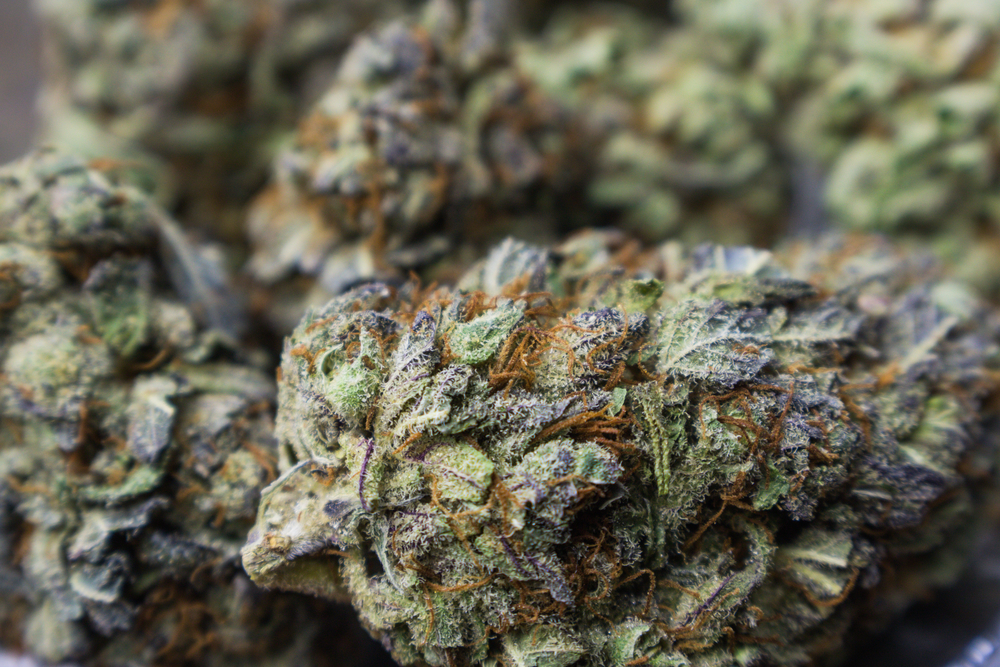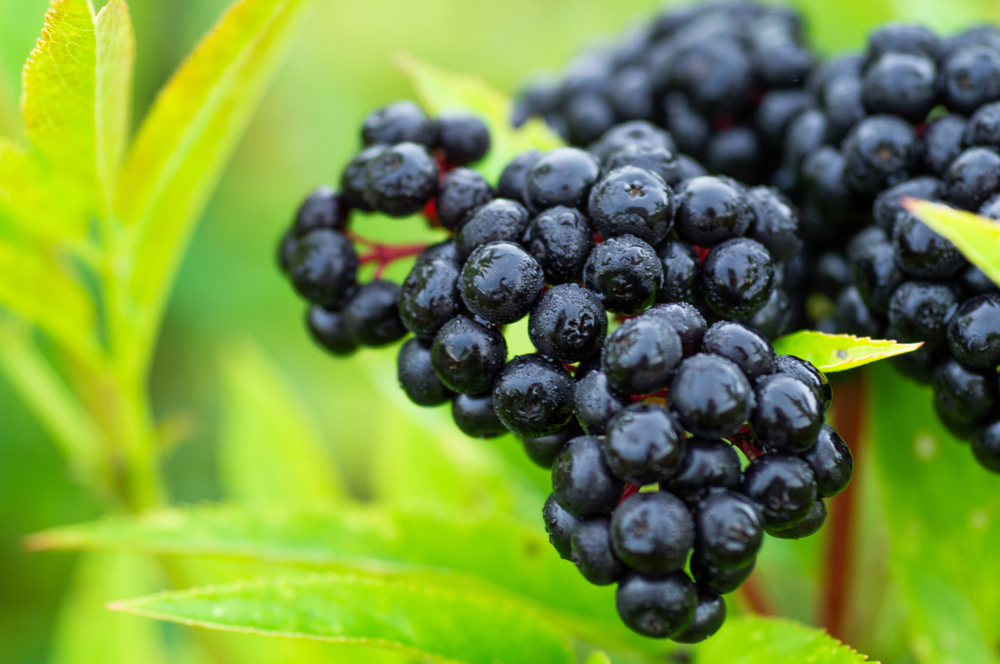We all love purple pot, but have you ever wondered what actually makes your buds produce those rich, deep violet tones?
Aside from cold temperatures – which I’ll discuss in more detail later as it’s the most common factor cited for purple buds – the real reason cannabis ends up being purple is because of a class of pigmented flavonoids known as Anthocyanins. These compounds are responsible for the fruity/berry flavor profiles and those beautiful purple, blue, and magenta tones we often see in top-shelf flower.
Some well-known and very popular purple strains are Grand Daddy Purps (GDP), Purple Haze, Mendocino Purps, Purple Kush, C4-Matic, and Dark Karma. Most purple strains are indicas or indica-dominant hybrids. Purple Haze is of the few exceptions to that rule; haze strains, like lemon haze and silver haze, are usually straight sativas.
To learn more about cannabis and get deals on flowers, subscribe to the CBD Flowers Weekly Newsletter
What are Anthocyanins?
The word “anthocyanin” is derived from two Greek words – Anthos meaning Flower and Kyanos meaning blue. Although we typically refer to cannabis with anthocyanins as “purple”, they can actually present in a variety of colors from deep reds to purples to blues. For the sake of uniformity in the article, we will refer to this entire range of colors as “violet”.
Anthocyanins are water-soluble pigment molecules belonging to a larger class of compounds known as Flavonoids. So far, there are over 400 types of anthocyanins that have been identified. They are not found in all plants, but in the ones in which they are present, they occur throughout the entire plant, including the leaves stems, roots, flowers, and fruits.
Anthocyanins are derived from anthocyanidins when excess sugar is produced by the plant, which becomes trapped as nutrient transport slows down. Although this only happens when temperatures drop slightly, sunlight is still a necessity to achieving the vibrant color that anthocyanins are infamous for. Freezing temps will destroy the pigment, but when temps are hot or too warm, plants will have excess chlorophyll, giving them those vibrant, green summertime tones. So, in other words, the conditions need to be just right for anthocyanins to flourish.
Anthocyanins, are known to be beneficial for human health, but they also have a specific purpose within the plant, which is to protect photosynthetic tissues from different types of light stressors. It blocks certain intensities and spectrums that could harm the plants, basically acting as natural sunblock.
It’s also believed that anthocyanin attracts pollinators such as bees, hummingbirds, and butterflies, while simultaneously deterring unwanted insects from laying eggs on the leaves. Pollinators are known to associate vibrant colors with healthy flowers, while other, unwanted insects will notice the dark pigments and think the plant is dying.
Making Pot Purple
Ah, yes… “purple pot”. People LOVE “purple pot”, me included. While the immediately noticeable effects aren’t much different than what you would feel from other strains of the same caliber, they do have some amazing flavor profiles.

Just like any other plant in nature, violet cannabis is created by cultivating certain strains in the correct environment. You can’t just take any strain, grow it in the cold, and have “purple buds”. You need certain strains, those containing anthocyanins with the predisposition to turn violet, and they need to be exposed to just the right level of cool temps at the correct point in the flowering stage. Cool enough that the purple and blue tones are enhanced without being so cold that the plant dies.
The pigment can also travel through plant, into the trichome stalks and even into the trichome head itself. Because of the potency of these pigments, cannabis only needs to product a minimal amount of Anthocyanins to get a noticeable, deep violet color.
What are the health benefits?
Since we humans have a symbiotic relationship with the world around us, even the background compounds like flavonoids can have major benefits for our health. When it comes to “purple foods” containing Anthocyanins, many are already categorized as “superfoods” with a slew of different therapeutic uses.
Anthocyanins are powerful antioxidants that inhibit the production of cell-damaging free radicals. In addition, these compounds are known to have anti-inflammatory, anti-viral, antibacterial, and anti-tumoral benefits. According to a 2017 study, “Anthocyanins are the value-added colorants that can be used for preventing several diseases, including CVDs, cancers, diabetes, some metabolic diseases, and microbial infection.”
Substances rich in anthocyanins have been used for centuries to treat many different conditions relating to the blood vessels, including high blood pressure and diabetic retinopathy. Because of their anti-viral and antibacterial properties, they’re also used to treat flus, colds, and urinary tract infections. Anthocyanins have also been linked to increased longevity, cardiovascular health, cancer prevention and dementia.
One especially interesting use for anthocyanins, is to improve vision. “Visual acuity can be markedly improved through administration of anthocyanin pigments to animal and human subjects, and the role of these pigments in enhancing night vision or overall vision has been particularly well documented,” stated a 2004 study.
Other plants containing Anthocyanins
Although cannabis with Anthocyanins have quite a loyal following, it’s only one of many plants containing this pigmented flavonoid. Anthocyanins is a dietary flavonoid also found in berries, red onions, black soybeans, kidney beans, pomegranates, grapes (and wine), tomatoes, acai, bilberry, chokeberry, elderberry, tart cherries, black rice, and many other plants with the violet pigment.

Anthocyanins are found in the highest concentrations in flowers and fruits, in the call vacuole. They are also found in leaves, stems, and roots, however. In those plant parts, Anthocyanins will mostly be in the outer layers which is why you may see violet tones over the entire plant.
There are numerous different types of Anthocyanins, and the ones that are most frequently found in nature are the glycosides of cyanidin, delphinidin, malvidin, pelargonidin, peonidin, and petunidin. During photosynthesis, 2% of all hydrocarbons are converted into flavonoids and their derivatives. Not all plants have flavonoids that will develop into Anthocyanins. In cacti, for example, the hydrocarbons turn into betalains. Anthocyanins and betalains have never been found in the same plant.
Final thoughts
To quickly sum it all up, purple buds are ah-maz-ing! Strains that are rich in Anthocyanins have great flavor profiles, usually earthy with hints of berry, they have numerous different health benefits, and the icing on the cake is that they look good and always impress.
Thanks for stopping by CBD FLOWERS, your hub for all things cannabis-related. Check back regularly and make sure to subscribe to the CBD Flowers Weekly Newsletter to stay up-to-date on all the most interesting and important industry topics.













